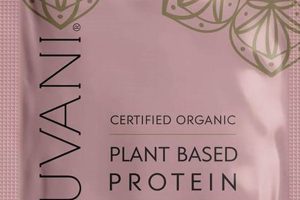Plant-based nutrition sources formulated into convenient, portable formats with minimal added sweeteners represent a growing segment of the health and wellness market. These products cater to individuals seeking to increase their protein intake while adhering to both vegan dietary guidelines and limitations on refined carbohydrates. As an example, a bar might derive its protein from pea protein isolate and utilize stevia as a sweetener to maintain a low sugar profile.
The rising popularity of such nutritional products stems from several factors including increasing awareness of plant-based diets, growing concerns about the health effects of excessive sugar consumption, and the demand for convenient, on-the-go nutritional options. Historically, protein bars often relied on animal-derived proteins like whey and significant amounts of added sugars. These modern alternatives provide a solution for a broader range of consumers with diverse dietary needs and preferences.
This exploration will delve into the key aspects of these specialized bars, encompassing ingredient profiles, nutritional considerations, formulation challenges, market trends, and potential health benefits for consumers seeking a healthy and convenient protein source.
Guidance on Selecting Plant-Based Protein Bars with Reduced Sweetener Content
The following guidelines are designed to aid in the informed selection of plant-based protein bars formulated to minimize sugar intake.
Tip 1: Scrutinize the Ingredient List. Prioritize bars with identifiable whole-food ingredients. Be aware of hidden sugars listed under names such as maltodextrin, dextrose, or corn syrup.
Tip 2: Assess the Protein Source. Opt for bars featuring a blend of plant-based protein sources like pea, brown rice, chia, or pumpkin seed protein for a complete amino acid profile.
Tip 3: Evaluate Sugar Content Per Serving. Aim for bars containing less than 5 grams of total sugar per serving. Compare this value against the overall carbohydrate content.
Tip 4: Consider the Fiber Content. Adequate fiber intake promotes satiety and digestive health. Look for bars containing at least 3 grams of fiber per serving.
Tip 5: Examine the Sweetener Profile. Be aware of the type of sweetener utilized. Natural, low-glycemic sweeteners such as stevia or monk fruit are preferable to artificial sweeteners or high-fructose corn syrup.
Tip 6: Understand Fat Composition. Prioritize bars containing healthy fats from sources like nuts and seeds while minimizing saturated and trans fats.
Tip 7: Watch for Additives and Fillers. Limit consumption of bars containing excessive artificial colors, flavors, or preservatives. A shorter ingredient list is generally preferable.
Tip 8: Evaluate the Overall Nutritional Profile. Consider the bar’s contribution to daily macronutrient and micronutrient needs. Ensure it aligns with individual dietary goals.
Adhering to these guidelines empowers individuals to make informed decisions, selecting options that effectively contribute to a balanced diet while satisfying protein requirements and minimizing sugar consumption.
The subsequent sections will further explore the benefits and limitations associated with the incorporation of these bars into a balanced dietary regimen.
1. Ingredient Sourcing
Ingredient sourcing is paramount in the production of plant-based protein bars with reduced sugar content, directly influencing nutritional profile, environmental impact, and ethical considerations. The origin and processing methods of each component determine the final product’s quality and sustainability.
- Protein Source Authenticity and Traceability
Ensuring the protein source, such as pea, brown rice, or soy protein, is genuinely plant-based and free from cross-contamination with animal products is crucial for maintaining vegan integrity. Traceability allows consumers to verify the source and processing methods, supporting ethical and sustainable practices. An example is a bar using certified organic pea protein sourced from farms employing regenerative agriculture.
- Sweetener Origin and Processing
The sourcing of low-sugar sweeteners, like stevia or erythritol, significantly impacts the final product’s healthfulness and environmental footprint. Stevia sourced from responsibly managed farms and erythritol produced through sustainable fermentation processes are preferable. Conversely, sourcing from regions with lax environmental regulations can lead to ecological damage.
- Fat Source Purity and Sustainability
The type and source of fats, such as those from nuts, seeds, or coconut oil, influence the bar’s fatty acid profile and overall health impact. Sourcing fats from sustainably harvested sources ensures minimal environmental disruption. For example, using sustainably sourced palm oil or opting for alternatives like sunflower or almond butter contributes to responsible production.
- Absence of Genetically Modified Organisms (GMOs)
Ingredient sourcing includes verifying the absence of genetically modified organisms (GMOs) in all components. Many consumers prefer non-GMO ingredients due to concerns regarding potential health and environmental effects. Certifications and transparent supply chains are essential to ensure ingredients are sourced from non-GMO crops.
The confluence of these sourcing factors significantly impacts the ultimate quality and consumer perception of plant-based protein bars with reduced sugar. Prioritizing transparent, sustainable, and ethical sourcing builds consumer trust and supports a healthier food system.
2. Protein Quality
The efficacy of plant-based protein bars with reduced sugar content hinges significantly on protein quality. Protein quality, encompassing amino acid profile, digestibility, and bioavailability, dictates the degree to which the bar effectively supports muscle protein synthesis and satiety. An incomplete amino acid profile, common in single-source plant proteins, may limit the bar’s effectiveness in promoting muscle recovery and growth. Therefore, the selection of protein sources, their combination, and any processing methods employed are critical determinants of the bar’s nutritional value.
Formulators of these bars often combine multiple plant protein sources, such as pea protein isolate, brown rice protein, and chia seeds, to achieve a more complete amino acid profile analogous to animal-based proteins. Furthermore, processing techniques, such as enzymatic hydrolysis, can enhance digestibility and bioavailability, increasing the utilization of the ingested protein. A bar relying solely on wheat protein, for instance, would offer lower protein quality compared to a bar utilizing a blend of complementary plant proteins treated to improve digestibility. This difference in protein quality directly affects the consumer’s physiological response and the bar’s functional benefit.
In conclusion, protein quality is a non-negotiable factor in assessing the nutritional merit of plant-based protein bars with reduced sugar. The careful selection and processing of protein sources are essential to maximizing the bar’s effectiveness in supporting muscle protein synthesis, satiety, and overall nutritional goals. A focus on protein quality mitigates potential limitations associated with plant-based protein sources, ensuring the bar provides tangible benefits to the consumer.
3. Sweetener Alternatives
The formulation of plant-based protein bars with reduced sugar relies heavily on the selection and application of appropriate sweetener alternatives. Traditional sugar, such as sucrose or high-fructose corn syrup, is typically avoided to maintain a low-sugar profile, necessitating the use of alternative sweetening agents. These alternatives aim to provide a palatable level of sweetness without contributing excessive calories or triggering significant blood glucose spikes. The specific choice of sweetener directly impacts the bar’s overall nutritional value, sensory characteristics, and suitability for individuals managing blood sugar levels or following specific dietary regimens. For instance, a bar sweetened with stevia, a natural non-caloric sweetener, will have a different metabolic effect compared to one using maltitol, a sugar alcohol that can cause gastrointestinal distress in some individuals. Thus, sweetener selection is a critical determinant of the bar’s functional properties and market appeal.
The spectrum of available sweetener alternatives is broad, encompassing natural non-nutritive sweeteners like stevia and monk fruit, sugar alcohols such as erythritol and xylitol, and modified sugars like allulose. Each alternative possesses distinct characteristics in terms of sweetness intensity, aftertaste, glycemic index, and potential side effects. Formulators must carefully consider these factors to achieve the desired sensory profile and minimize any adverse effects. For example, using a blend of stevia and erythritol can mitigate the bitter aftertaste often associated with high concentrations of stevia, while also reducing the overall caloric contribution. Furthermore, the regulatory status and consumer perception of each sweetener can influence its suitability for specific markets and product positioning.
In summary, sweetener alternatives are integral to the development of plant-based protein bars with reduced sugar, offering a means to achieve desired sweetness levels without the negative health consequences associated with traditional sugars. The careful selection and application of these alternatives are essential for creating products that are both palatable and nutritionally sound. The ongoing research and development in this area continue to expand the options available to formulators, allowing for the creation of innovative and health-conscious products that meet the evolving needs of consumers.
4. Fiber Content
The presence of fiber within plant-based protein bars formulated to minimize sugar intake constitutes a critical element influencing satiety, glycemic control, and overall digestive health. A deficiency in dietary fiber often results in diminished feelings of fullness, potentially leading to increased caloric consumption. Conversely, adequate fiber intake, particularly from sources inherent to plant-based ingredients like oats, seeds, or legumes, promotes a sustained release of energy, mitigating rapid spikes in blood glucose levels. For example, a bar containing 5 grams of fiber derived from chia seeds will generally elicit a more moderate insulin response compared to a bar devoid of fiber, assuming comparable carbohydrate content. The inclusion of fiber is thus integral to managing postprandial glucose excursions, a factor of significant importance for individuals with diabetes or those seeking to stabilize energy levels throughout the day.
Beyond its impact on satiety and glycemic regulation, fiber exerts a profound influence on gut microbiota composition and function. Soluble fiber, such as that found in oats or psyllium husk, serves as a prebiotic, fostering the growth of beneficial bacterial strains within the colon. These bacteria, in turn, produce short-chain fatty acids (SCFAs) like butyrate, acetate, and propionate, which contribute to colonic health, immune modulation, and even systemic energy metabolism. A practical application of this understanding involves formulating these bars with a combination of soluble and insoluble fiber to maximize both prebiotic benefits and promote regular bowel movements. Insoluble fiber, derived from ingredients like flaxseed or whole grains, adds bulk to the stool, facilitating intestinal transit and preventing constipation. Therefore, the careful selection and incorporation of diverse fiber sources are paramount to optimizing the physiological benefits of such nutritional products.
In summary, the strategic inclusion of fiber in plant-based protein bars with reduced sugar extends beyond mere filling capacity; it encompasses a complex interplay of physiological effects, spanning satiety regulation, glycemic control, and gut microbiome modulation. Challenges remain in achieving optimal fiber content without compromising taste or texture, necessitating innovative ingredient combinations and processing techniques. Recognizing the multifaceted role of fiber underscores its significance in contributing to the overall health-promoting potential of these specialized food products, positioning them as a valuable component within a well-balanced dietary regimen.
5. Macronutrient Balance
Macronutrient balance constitutes a fundamental consideration in the formulation and consumption of plant-based protein bars with reduced sugar content. The relative proportions of protein, carbohydrates, and fats significantly impact satiety, energy levels, and metabolic responses. An appropriate macronutrient profile ensures that the bar effectively contributes to dietary goals without causing adverse physiological effects.
- Protein Contribution and Amino Acid Profile
Plant-based protein bars should provide a substantial quantity of protein, typically ranging from 10 to 20 grams per serving, to support muscle protein synthesis and satiety. The protein source should ideally offer a complete or near-complete amino acid profile, potentially achieved through a blend of plant-based proteins such as pea, brown rice, and quinoa. An insufficient protein content may diminish the bar’s ability to suppress appetite and support muscle recovery after exercise.
- Carbohydrate Composition and Glycemic Impact
While designed to be low in sugar, these bars invariably contain carbohydrates. The carbohydrate source and its impact on blood glucose levels are critical. Complex carbohydrates, such as those derived from oats or sweet potato powder, are preferable to simple sugars. A high proportion of simple sugars can negate the benefits of reduced sugar content, leading to rapid glucose spikes and potential insulin resistance. Fiber content also influences the glycemic impact of the carbohydrate component.
- Fat Content and Fatty Acid Profile
The fat content contributes to satiety and provides essential fatty acids. Unsaturated fats, derived from sources like nuts, seeds, or avocado oil, should predominate over saturated and trans fats. A balanced fatty acid profile supports cardiovascular health and enhances the absorption of fat-soluble vitamins. Excessive fat content, especially saturated fat, can detract from the bar’s overall healthfulness.
- Caloric Density and Portion Control
The macronutrient balance directly influences the caloric density of the bar. An appropriate macronutrient ratio, coupled with portion control, is essential for managing weight and preventing excessive caloric intake. A bar with a high fat content relative to protein and carbohydrates may be calorie-dense, requiring careful consideration of portion size to align with individual energy needs.
In conclusion, macronutrient balance is a key determinant of the nutritional value and functional benefits of plant-based protein bars with reduced sugar. A well-formulated bar provides a balanced ratio of protein, carbohydrates, and fats to support satiety, manage blood glucose levels, and contribute to overall dietary goals. The selection of appropriate ingredients and careful attention to macronutrient proportions are essential for creating a product that effectively meets consumer needs and promotes health.
6. Glycemic Impact
Glycemic impact, a measure of how rapidly a food elevates blood glucose levels, is a critical consideration in the formulation and selection of plant-based protein bars with reduced sugar. These bars are often consumed as meal replacements or post-exercise snacks, making their influence on blood sugar regulation particularly relevant. A high glycemic impact can lead to rapid glucose spikes, triggering an excessive insulin response, which may contribute to insulin resistance and increased fat storage over time. Conversely, a lower glycemic impact results in a more gradual and sustained release of glucose, promoting stable energy levels and improved metabolic control. The primary objective is to minimize the glycemic excursion following consumption, thereby mitigating adverse physiological effects. For example, a bar formulated with dates as a primary sweetener would likely exhibit a higher glycemic impact than one sweetened with stevia and incorporating a significant fiber content, even if both bars contain a similar amount of total carbohydrates.
The glycemic impact of these bars is not solely determined by the type and quantity of sweeteners used. The interplay between carbohydrates, protein, fat, and fiber significantly influences the overall glycemic response. Protein and fat slow gastric emptying, delaying the absorption of glucose, while soluble fiber forms a viscous gel in the digestive tract, further attenuating glucose absorption. The physical form of the bar also plays a role; a densely packed bar may exhibit a slower release of glucose compared to a more aerated and processed bar. Therefore, a holistic assessment of ingredient composition and processing methods is essential for accurately predicting and managing glycemic impact. Real-world applications of this understanding involve formulating bars with low-glycemic index ingredients, such as nuts, seeds, and non-starchy vegetables, and incorporating strategies to enhance protein and fiber content.
In conclusion, understanding and controlling glycemic impact is paramount to optimizing the health benefits of plant-based protein bars with reduced sugar. While minimizing added sugars is a crucial step, a comprehensive approach that considers the interaction of macronutrients, fiber content, and processing methods is necessary to achieve a low glycemic response. Challenges persist in accurately predicting the glycemic impact of complex food matrices, necessitating ongoing research and development of formulation strategies that effectively manage blood glucose levels. The successful integration of these principles is essential for creating products that align with the needs of individuals seeking sustained energy, improved metabolic control, and overall health benefits.
Frequently Asked Questions
This section addresses common inquiries and misconceptions regarding plant-based protein bars formulated to minimize sugar content.
Question 1: Are plant-based protein bars with reduced sugar nutritionally complete?
Nutritional completeness varies significantly among different brands and formulations. While many offer a substantial source of protein and fiber, they may not provide a comprehensive range of vitamins and minerals comparable to a balanced whole-food diet. Scrutinizing the nutrition label and ingredient list is essential to assess the bar’s overall nutritional profile.
Question 2: Can these bars effectively contribute to muscle growth and repair?
The efficacy of plant-based protein bars in supporting muscle growth and repair depends on the quantity and quality of protein they contain. Bars with a complete amino acid profile, derived from a blend of plant-based sources, are more likely to promote muscle protein synthesis effectively. An adequate protein intake is crucial, typically ranging from 0.8 to 1.0 grams per kilogram of body weight per day, depending on activity level.
Question 3: Are there potential downsides to consuming sugar alcohol sweeteners in these bars?
Sugar alcohols, such as erythritol or xylitol, are commonly used to reduce sugar content. However, some individuals may experience gastrointestinal discomfort, including bloating, gas, or diarrhea, following their consumption. The severity of these effects varies depending on individual sensitivity and the quantity consumed. Moderation is advised.
Question 4: How do plant-based protein bars with reduced sugar compare to traditional protein bars?
Traditional protein bars often rely on animal-derived proteins and contain higher levels of added sugars. Plant-based alternatives offer a suitable option for individuals adhering to vegan diets or seeking to minimize sugar intake. However, protein quality and ingredient sourcing should be carefully evaluated to ensure nutritional equivalence or superiority.
Question 5: Are all ingredients in these bars truly vegan?
While marketed as vegan, certain ingredients may be of questionable origin or processed using non-vegan methods. Thoroughly examining the ingredient list and seeking out certified vegan products can help ensure adherence to vegan principles. Common points of concern include the source of “natural flavors” or the use of refined sugar processed with bone char.
Question 6: Can these bars be a sustainable source of nutrition?
The sustainability of these bars depends on ingredient sourcing, packaging materials, and production practices. Opting for bars with sustainably sourced ingredients, minimal packaging, and eco-friendly production methods can contribute to a more environmentally responsible choice. Consideration should be given to the environmental impact of the bar’s entire life cycle.
In summary, plant-based protein bars with reduced sugar offer a convenient source of protein and fiber, but their nutritional value and suitability depend on careful ingredient selection and consideration of individual dietary needs.
The subsequent section will provide guidance on incorporating these bars into a well-balanced diet and addressing potential health concerns.
Conclusion
The preceding exploration has elucidated key aspects of plant-based protein bars formulated for reduced sugar content. Ingredient sourcing, protein quality, sweetener alternatives, fiber content, macronutrient balance, and glycemic impact are critical determinants of the nutritional value and physiological effects associated with these products. Informed selection and judicious consumption are essential for maximizing potential health benefits.
Continued research and development are necessary to address existing limitations and optimize the formulation of these nutritional products. Consumers are encouraged to critically evaluate product labeling and consider individual dietary needs when incorporating “vegan protein bars low sugar” into a balanced eating plan. The ongoing evolution of this market segment holds the potential for creating more effective and sustainable dietary options.




![Boost Protein: Vegan Alfredo Recipe [Healthy & Easy!] Discover Delicious Vegan Food, Beauty Swaps, and Zero-Waste Tips for a Greener Life Boost Protein: Vegan Alfredo Recipe [Healthy & Easy!] | Discover Delicious Vegan Food, Beauty Swaps, and Zero-Waste Tips for a Greener Life](https://thisvegangirl.com/wp-content/uploads/2025/12/th-956-300x200.jpg)


